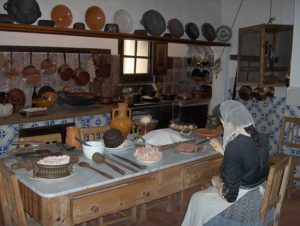I’m having my kitchen remodeled, a daunting and messy project that is not yet complete. Naturally, this event sparked the question in my historically-minded imagination about Regency kitchens. This, of course, led to research. But first, I thought I’d share photos of my unimpressive kitchen.
The homebuilder originally installed two lower cabinets, two and a half uppers, and a drawer bank which is next to the sink and dishwasher on the island. No doubt someone from a hundred years ago would have found it luxurious, but as a spoiled modern-day woman, I found it wholly inadequate with nowhere near enough counter space–so did the previous owners, apparently because they installed a set of ugly but utilitarian cabinets in the far left corner. Still, the kitchen does not have enough counter space. If any dishes are left on the sink, a frequent occurrence in our house full of children, there is little to no space for food preparation.
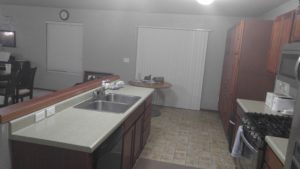

view 2 of pre-demolition kitchen


Last week, we tore out everything.

First we packed, as modeled by my youngest son to the right. We did the demolition ourselves to save money. My oldest son and daughter-in-law were visiting at the time, and they had so much fun helping. I had more fun caring for my granddaughter and keeping her away from the mess. Thanks to their help, it was kinda fun, but certainly very messy. Here are the demolition photos:

When the kitchen is finished, I’ll post completed photos. But for now, let’s move on to the historical tie-in.
Most of my characters are wealthy enough not to spend much time in a kitchen and certainly never need to cook for themselves–a far cry from my reality. They probably wouldn’t know how to cook over a hearth use an oven.
Still, what were kitchens like in Regency England?
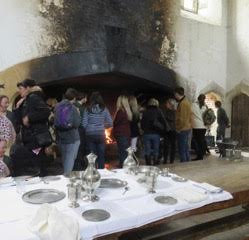
Food and kitchens, like clothing, education, and social issues, underwent great change in the late Regency/early Victorian Era. Before that time, food in England was more primitive than that found in France and Germany, and other European countries. Ovens were inefficient and produced a great deal of smoke. Notice the soot in this photo to the right above the tourists’ heads.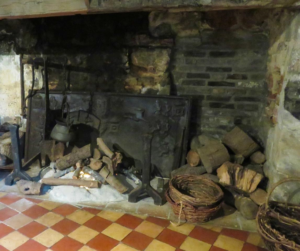
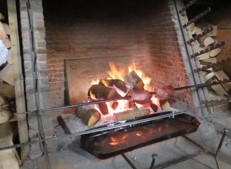
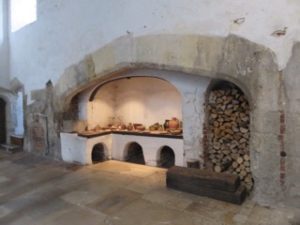
Cooking was done over the hearth on spit or in posts hanging over the fire. Baking occurred in large ovens.
As far as storing food and cooking implements, they had some cupboards, but most seemed to have used shelves or a larder. Food stayed cold in a bultery, or buttery.
During the Georgian and Regency Eras, great food had become an integral part of family and social life. Many kitchens were updated from hearths, to either the Rumford fireplace, which allowed for better air circulation and therefore more effective cooking, or to even more modern cooking ranges. )Unfortunately, I have yet to find a photo of this “new fangled” range. If you have one that you are willing to share, please let me know.)
The most innovated houses now boasted plumbing for both hot and cold water. New kitchen designs and even took advantage of light, minimized odors and regulated temperature.
These three photos, courtesy Shannon Arthur, are from One Royal Crescent in Bath. The house is restored to the Georgian era circa 1770s with some items as late as 1832 added. Apparently, they occasionally used 1800s reproductions of the 1770s stuff that had been sold off.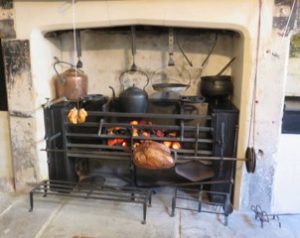
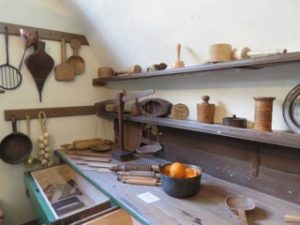
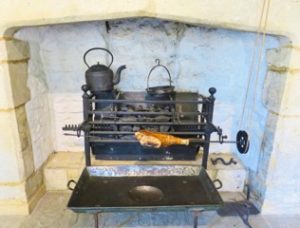
I found this photo to the left on Wickimedia Commons, but I cannot identify if this is a colonial or English kitchen, nor if this is during the early or late 1800’s. Still, it gives a good feel for what kitchens must have been like. Countertops did not exist for centuries. Instead, servants used large tables to do all their food preparation. Eventually, marble or other stone slabs appeared on these tabletops, as pictured in this photo to the right, which probably made the entire process easier and cleaner.
Here is a stove, circa late 1800s. 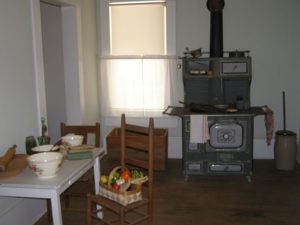 It features a very modern-looking stove, but the table does not look authentic to me. Still, it shows a butter churn, and gives a fun historical feel overall.
It features a very modern-looking stove, but the table does not look authentic to me. Still, it shows a butter churn, and gives a fun historical feel overall.
Compared to these photos, my old kitchen was pretty posh, but I can’t wait to get my new kitchen, complete with new drawers, cupboards, and a nice, big island. Oh, and running water. Yeah, that will be great!

